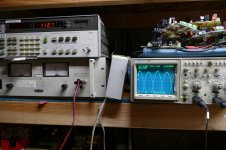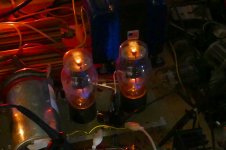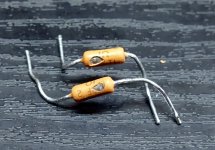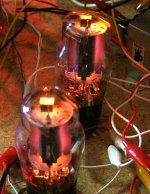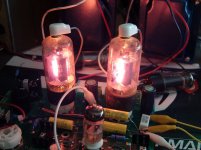Let's revive the thread!
I started putting together the push-pull 6L6GC stage I mentioned in the OP, and I was aiming at a 450V B+. Today I tested my power transformer with a 4k resistive load (to simulate the about 115mA I will draw) and the B+ was about 470V.
Do you think it would be safe for a pair of 6L6 to have 470V for B+? I assume this could rise up to 510V if mains rises too (unlikely, but anyway). From previous posts, I feel that it does not need to concern me, but I don't find many amps with a pair of 6L6 going above 450V. 😕
EDIT: about 45mA bias for each 6L6
I started putting together the push-pull 6L6GC stage I mentioned in the OP, and I was aiming at a 450V B+. Today I tested my power transformer with a 4k resistive load (to simulate the about 115mA I will draw) and the B+ was about 470V.
Do you think it would be safe for a pair of 6L6 to have 470V for B+? I assume this could rise up to 510V if mains rises too (unlikely, but anyway). From previous posts, I feel that it does not need to concern me, but I don't find many amps with a pair of 6L6 going above 450V. 😕
EDIT: about 45mA bias for each 6L6
Va max is given as 500v, max anode diss = 30w, this from a GE datasheet, whether a contemporary valve with handle this is another matter.
Andy.
Andy.
https://www.tungsol.com/specs/6l6gcstr-tung-sol.pdf
This is the datasheet Tung Sol gives for the tubes I have.
It specifies 500V for both anode and screen.
This is the datasheet Tung Sol gives for the tubes I have.
It specifies 500V for both anode and screen.
I assume you are going to use fixed bias. If not, the cathode voltage ofcourse has to be subtracted from Va and Vg2.
Attached are some schematics of audio amplifiers in which the 6L6GC's are being run with Vba and Vbg2 higher than 450 V.
In guitar amplifiers you often see that Vba, and even Vbg2, are higher than 450 V. Some examples:
Fender Bassman 10: Vba = 490 V / Vbg2 = 455 V
Fender Bassman 10/75W: Vba+g2 = 500 V (ultra linear)
Fender Bassman 135: Vba+g2 = 500 V (ultra linear)
Fender Bassman 59: Vba = 491 V / Vbg2 = 490 V
Attached are some schematics of audio amplifiers in which the 6L6GC's are being run with Vba and Vbg2 higher than 450 V.
In guitar amplifiers you often see that Vba, and even Vbg2, are higher than 450 V. Some examples:
Fender Bassman 10: Vba = 490 V / Vbg2 = 455 V
Fender Bassman 10/75W: Vba+g2 = 500 V (ultra linear)
Fender Bassman 135: Vba+g2 = 500 V (ultra linear)
Fender Bassman 59: Vba = 491 V / Vbg2 = 490 V
Attachments
-
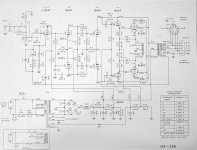 0,5 x 12AX7 dc-coupled + 12AU7 + 12BH7 + 12AX7 dc-coupled c-follower + 2 x 6L6GC cfb pp (Mcintos.jpg308.6 KB · Views: 237
0,5 x 12AX7 dc-coupled + 12AU7 + 12BH7 + 12AX7 dc-coupled c-follower + 2 x 6L6GC cfb pp (Mcintos.jpg308.6 KB · Views: 237 -
 2 x EF86 supertriode + 12AX7 + EF86 supertriode transformer-coupled + 4 x 6L6GC + 2 x 0B2 (Bouye.jpg148.5 KB · Views: 284
2 x EF86 supertriode + 12AX7 + EF86 supertriode transformer-coupled + 4 x 6L6GC + 2 x 0B2 (Bouye.jpg148.5 KB · Views: 284 -
12AX7 + 6SN7 transformer-coupled + 2 x 6L6G cfb pp + 5U4GB + 5Y3 (McIntosh).pdf1.2 MB · Views: 159
-
4 x 12AX7 + 12AU7 srpp + 12AU7 dc-coupled + 4 x 6L6GC pp (Unicord U-1086).pdf614 KB · Views: 97
-
3 x 12AX7 + 12AU7 + 4 x 6L6GC pp (Unicord U-1075).pdf565.1 KB · Views: 89
Last edited:
I assume you are going to use fixed bias. If not, the cathode voltage ofcourse has to be subtracted from Va and Vg2.
Attached are some schematics of audio amplifier in which the 6L6GC's are being run with Vba and Vbg2 higher than 450 V.
In guitar amplifiers you often see that Vba, and even Vbg2, are higher than 450 V. Some examples:
Fender Bassman 10: Vba = 490 V / Vbg2 = 455 V
Fender Bassman 10/75W: Vba+g2 = 500 V (ultra linear)
Fender Bassman 135: Vba+g2 = 500 V (ultra linear)
Fender Bassman 59: Vba = 491 V / Vbg2 = 490 V
Many thanks for your wonderful answer.
Yes, I will use fixed bias.
I tried but did not find any examples of guitar amps with more than 450V in schematics around the net, but maybe my search was not quite good. Many thanks for that.
So, even if mains swings up 10% and B+ ends up being 515V, the tubes would be safe anyway? Or are we counting on that this will be less of 10% (if not 0,01% 😛) of a tube's life so it doesn't hurt that bad?
We are talking about modern tubes, which I don't know (I don't question it, I just don't know it) if are as rugged as older tubes were. Regarding this, the guitar amp examples you refer to are old builds or new production?
I also don't know if all 6L6GC's produced nowadays can take these kind of voltages. I don't have a guitar amp with 6L6GC's.
My guess is that these matters are (mostly) discussed on guitar(amp) related forums/sites.
The schematics of Fender guitar amps I mentioned are in this document (there are similar documents for brands like Gibson, Marshall, etc. to be found on the internet): https://www.kevinchant.com/uploads/7/1/0/8/7108231/fender.pdf
Caution: File is about 57 MB.
My guess is that these matters are (mostly) discussed on guitar(amp) related forums/sites.
The schematics of Fender guitar amps I mentioned are in this document (there are similar documents for brands like Gibson, Marshall, etc. to be found on the internet): https://www.kevinchant.com/uploads/7/1/0/8/7108231/fender.pdf
Caution: File is about 57 MB.
Last edited:
I haven't tested many new production 6L6GC's, except for some cheap Chinese tubes and they worked fine at 500 volts. I took a pair of 1940's vintage 6L6GA's and tried to find their true power limits. The amp ran AB2 into a 3300 ohm OPT. I kept increasing the B+ voltage and drive level to achieve more power. These tubes can achieve far more power than their ratings.
I was at 500 volts and 112 watts of output from the pair, and left it there for several minutes while I took measurements and pictures. The picture shows the tubes with the room lights off. I cranked up the brightness of the image in a photo editor to look for glowing parts.....there aren't any. The next picture shows the scope probe on each grid revealing nearly 45 volts of positive grid swing, the analyzer reading 112.7 watts at 3%THD, and the plate power supply at 500 volts and 700 mA (two channels operating). Assuming that the current was split evenly between the channels, one pair ate 350 mA at about 485 volts (15V drop in the OPT). This is a plate efficiency of about 66% which is quite good for 75 year old tubes!
I turned the drive up further and somewhere around 120 watts the cathode resistor exploded due to a tube arc. I replaced the cathode resistor and repeated the test only to have a different resistor pop again at the same power level.
A tube arc occurs when the current density exceeds the cathode's emission capability. In this case the tubes were not significantly damaged, but I have seen some TV sweep tubes explode when a tube arc of several Amps occurs.
This indicates that you should have no problems running any well made 6L6 type tube at 500 volts of B+......just don't aim for over 100 watts!
I was at 500 volts and 112 watts of output from the pair, and left it there for several minutes while I took measurements and pictures. The picture shows the tubes with the room lights off. I cranked up the brightness of the image in a photo editor to look for glowing parts.....there aren't any. The next picture shows the scope probe on each grid revealing nearly 45 volts of positive grid swing, the analyzer reading 112.7 watts at 3%THD, and the plate power supply at 500 volts and 700 mA (two channels operating). Assuming that the current was split evenly between the channels, one pair ate 350 mA at about 485 volts (15V drop in the OPT). This is a plate efficiency of about 66% which is quite good for 75 year old tubes!
I turned the drive up further and somewhere around 120 watts the cathode resistor exploded due to a tube arc. I replaced the cathode resistor and repeated the test only to have a different resistor pop again at the same power level.
A tube arc occurs when the current density exceeds the cathode's emission capability. In this case the tubes were not significantly damaged, but I have seen some TV sweep tubes explode when a tube arc of several Amps occurs.
This indicates that you should have no problems running any well made 6L6 type tube at 500 volts of B+......just don't aim for over 100 watts!
Attachments
Well, thanks for your excellent reply. Very informative!
So I guess that even running at 515 because mains has risen, should not harm them if wattage is at normal levels (50-55 watts). As a result, 470V B+ is fine for nominal mains voltage.
So I guess that even running at 515 because mains has risen, should not harm them if wattage is at normal levels (50-55 watts). As a result, 470V B+ is fine for nominal mains voltage.
6L6 abuse has a verrry long history. The original 6L6 ratings had to be walked-back about 10% because so many designers pushed too hard. The TungSol 5881 was specifically devised to replace 6L6 in sockets where 6L6 were dying too often. Much of this malarkey stopped when tube-TV research pushed all the limits with mass money and the 6L6GC fell out of that progress.
NO 'modern' 6L6 type will fail fast at 500V.... if it did the customer returns would bury the factory, because so many g-amps run 500V or more.
The 6BG6 is an old-build 6L6GC with a top-cap. (Actually the GC is a 6BG6 minus the top-cap.) 6BG6 is nominally rated 700V on plate. However the G2 rating is 350V, lower than 6L6GC. Different tube? No, just that in H-sweep work a high G2 is liable to trouble, while in audio work trouble is less likely and it may be convenient if Vg2 is 90% of Vp (so we don't need another power supply). 6BG6 is also rated 20W instead of the nominal 30W of the GC. While I don't think the GC is the biggest 30 Watt tube in town, the 20W rating on 6BG6 is because small drift in a H-sweep circuit makes BIG change in dissipation so a huge factor of safety is needed for business reasons.
Come to think.... the Univox 1011 ran 6L6GC at 650V. I maintained one (or a sibling) and that was the honest voltage. The factory tubes were ordinary 1970s Japanese product (good but not the best) and gave no trouble. Early production models are sometimes found mouse-infested but in good working order. (Late production shifted to cheap rectifiers and caps and has cheap-amp troubles.)
https://el34world.com/charts/Schematics/files/Univox/Univox1011.pdf
NO 'modern' 6L6 type will fail fast at 500V.... if it did the customer returns would bury the factory, because so many g-amps run 500V or more.
The 6BG6 is an old-build 6L6GC with a top-cap. (Actually the GC is a 6BG6 minus the top-cap.) 6BG6 is nominally rated 700V on plate. However the G2 rating is 350V, lower than 6L6GC. Different tube? No, just that in H-sweep work a high G2 is liable to trouble, while in audio work trouble is less likely and it may be convenient if Vg2 is 90% of Vp (so we don't need another power supply). 6BG6 is also rated 20W instead of the nominal 30W of the GC. While I don't think the GC is the biggest 30 Watt tube in town, the 20W rating on 6BG6 is because small drift in a H-sweep circuit makes BIG change in dissipation so a huge factor of safety is needed for business reasons.
Come to think.... the Univox 1011 ran 6L6GC at 650V. I maintained one (or a sibling) and that was the honest voltage. The factory tubes were ordinary 1970s Japanese product (good but not the best) and gave no trouble. Early production models are sometimes found mouse-infested but in good working order. (Late production shifted to cheap rectifiers and caps and has cheap-amp troubles.)
https://el34world.com/charts/Schematics/files/Univox/Univox1011.pdf
6L6 abuse has a verrry long history.
Guilty as charged......
I pulled this pair of Chinese Ruby Tube "6L6GC's" out of a working Bandmaster because the owner wanted something different (Sovteks I think). This was about 20 years ago. I still have them and they still work. They are dissipating about 44 watts in a SE amp in this picture.
They were no match from an extreme overload test using some 6BQ6GA's I got for 79 cents each. These were sold as new tubes, but this pair was old, crusty looking and not so good. They became a little less good after this test, but did still work. One would blow up eventually trying to push the watts per $$$ limit.
Attachments
Some 6BG6GA manufactured by Sylvania and Philips-ECG have a large plate that can be loaded up to ~ 35W (probably from the 7581A tube system) and work without problems with voltages on the plate up to 700V and on the G2 up to 450V.6L6 abuse has a verrry long history. The original 6L6 ratings had to be walked-back about 10% because so many designers pushed too hard. The TungSol 5881 was specifically devised to replace 6L6 in sockets where 6L6 were dying too often. Much of this malarkey stopped when tube-TV research pushed all the limits with mass money and the 6L6GC fell out of that progress.
NO 'modern' 6L6 type will fail fast at 500V.... if it did the customer returns would bury the factory, because so many g-amps run 500V or more.
The 6BG6 is an old-build 6L6GC with a top-cap. (Actually the GC is a 6BG6 minus the top-cap.) 6BG6 is nominally rated 700V on plate. However the G2 rating is 350V, lower than 6L6GC. Different tube? No, just that in H-sweep work a high G2 is liable to trouble, while in audio work trouble is less likely and it may be convenient if Vg2 is 90% of Vp (so we don't need another power supply). 6BG6 is also rated 20W instead of the nominal 30W of the GC. While I don't think the GC is the biggest 30 Watt tube in town, the 20W rating on 6BG6 is because small drift in a H-sweep circuit makes BIG change in dissipation so a huge factor of safety is needed for business reasons.
Come to think.... the Univox 1011 ran 6L6GC at 650V. I maintained one (or a sibling) and that was the honest voltage. The factory tubes were ordinary 1970s Japanese product (good but not the best) and gave no trouble. Early production models are sometimes found mouse-infested but in good working order. (Late production shifted to cheap rectifiers and caps and has cheap-amp troubles.)
https://el34world.com/charts/Schematics/files/Univox/Univox1011.pdf
>200W with 6BG6GA
Some 6BG6GA manufactured by Sylvania and Philips-ECG have a large plate that can be loaded up to ~ 35W (probably from the 7581A tube system)
Sylvania/Philips ECG was famous for stuffing the glass with whatever they had to fulfill government and industrial contracts in a time period when tube production was dwindling and lines were shutting down or being consolidated. In many cases the tubes were not sold to the general public, just to the contract owner, but these are now surplus.
The most famous was the 6B4GA. The 6B4G is an ST shaped DHT. The 6B4GA is a straight sided bottle with 6AV5GA TV sweep pentode tube guts inside wired as a triode and pinned to match the 6B4G.
The "super 6BG6GA's" contained 7027A guts as did some 6L6GC's and 807's. This was just a case of make one set of guts for several tubes, and the 7027A is the strongest of the 6L6 derivatives and generally works well in all 6L6 type circuits.
SND tube sales wound up with over 10,000 of these tubes. I bought a box full when they were $4 each. I put some into guitar amps and they lived forever.
6BG6 To 6L6 Vacuum Tube List
- Home
- Amplifiers
- Tubes / Valves
- Tube maximum voltages
